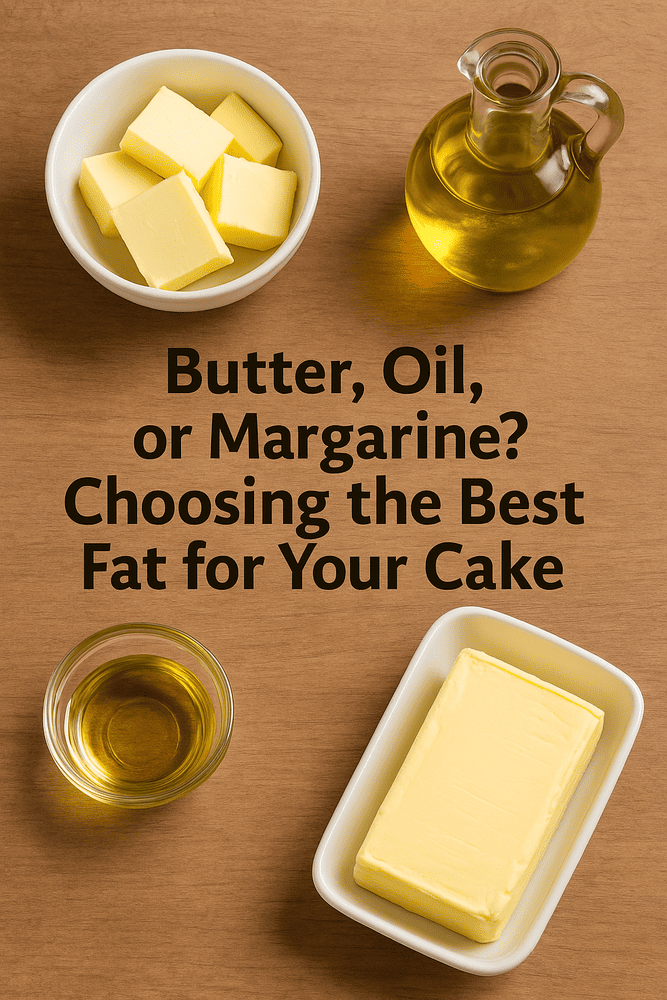When it comes to baking cakes, the fat you choose is more than just a flavor contributor—it’s a structural element that affects texture, moisture, rise, and even shelf life. Whether you’re using butter, oil, or margarine, each type of fat behaves differently during mixing and baking. Understanding these differences will help you choose the right one for the kind of cake you want to make.
Let’s start with the classic: butter. It’s a staple in many cake recipes and is beloved for the rich flavor and creamy texture it provides. Butter contains around 80% fat, with the remaining portion being water and milk solids. This combination creates steam during baking, helping cakes rise slightly and giving them a tender crumb.
Butter is solid at room temperature, which means cakes made with butter are typically more structured and hold their shape well. When creamed with sugar, butter traps air in the batter, contributing to lightness and volume. This makes it ideal for cakes like pound cake, vanilla sponge, or layered birthday cakes where both texture and flavor matter.
However, butter has limitations. Because it solidifies when cold, butter-based cakes can become firm or even dry when refrigerated. It also has a lower melting point than some other fats, which can impact stability in warm environments.
Next, let’s talk about oil. Vegetable oil, canola oil, and sunflower oil are commonly used in cakes for their ability to keep the crumb moist and tender for days. Unlike butter, oil is liquid at room temperature, which means it coats flour particles more thoroughly. This reduces gluten formation, resulting in a softer, more delicate texture.
Oil is ideal for cakes where moisture is a priority—like carrot cake, chocolate cake, or snack cakes. It doesn’t contribute much flavor, but its neutral profile allows other ingredients (like spices, fruits, or cocoa) to shine. Oil-based cakes also remain soft in the refrigerator, making them a great choice for make-ahead bakes or frosted cakes that need to be chilled.
One downside to oil is that it doesn’t hold air the same way butter does. This means oil-based cakes may rise less and have a tighter crumb. You can compensate by using chemical leaveners like baking soda or eggs whipped separately.
Then there’s margarine, a butter substitute made from vegetable oils. It typically contains less fat and more water than butter, and its performance in baking varies widely depending on the brand and formulation. Some margarines are designed for spreading and contain too much water, which can affect cake structure and texture.
High-fat margarine (at least 80% fat) can be used as a substitute for butter in most recipes, especially if cost or dietary needs are a factor. It creams with sugar like butter and offers a similar mouthfeel, though often with less flavor. For consistent results, always check the label for fat content before baking with margarine.
So, which one should you use? The answer depends on the type of cake you’re making and what characteristics you value most.
- For flavor and structure: Butter is the go-to for classic cakes like pound cake, butter cake, or vanilla layer cakes. It delivers rich taste and a pleasing crumb.
- For moistness and softness: Oil works best in cakes where tenderness is key—think chocolate cake, banana bread, or spiced cakes. It also extends shelf life.
- For economy or dairy-free needs: High-fat margarine can substitute for butter in many recipes, though you may sacrifice some flavor.
Here’s a quick breakdown of how these fats compare:
| Fat Type | Fat Content | Texture Result | Flavor | Best Used For |
|---|---|---|---|---|
| Butter | ~80% | Tender, structured | Rich, creamy | Pound cakes, layer cakes |
| Oil | 100% | Very moist, soft | Neutral | Chocolate, carrot, banana cakes |
| Margarine | Varies (60–80%) | Tender if high-fat | Mild or artificial | Dairy-free or budget recipes |
Some bakers also blend fats to combine benefits. For example, a recipe might use both oil (for moisture) and butter (for flavor). Others might use yogurt, sour cream, or cream cheese alongside fat to enhance texture and taste.
Important tips when using fats in baking:
- Bring butter to room temperature for proper creaming—about 18–22°C
- Avoid low-fat margarines unless the recipe specifically allows
- Don’t overmix oil-based batters, as this can deflate structure
- Weigh your ingredients for better accuracy, especially fats
Also, be mindful of storage. Butter-based cakes firm up when refrigerated and should be brought to room temperature before serving. Oil-based cakes are more forgiving and stay moist even when chilled.
As with flour, eggs, and sugar, fat selection is part of the science—and art—of cake baking. Each one brings its own unique properties, and knowing when and how to use them will elevate your baking from average to extraordinary.
If you’ve followed our past articles on ingredients like eggs, sugar, and flour, this one helps complete the foundation of cake chemistry. Up next in Article #9: we’ll explore the role of dairy and liquids in building cake structure, richness, and softness. Stay tuned!
